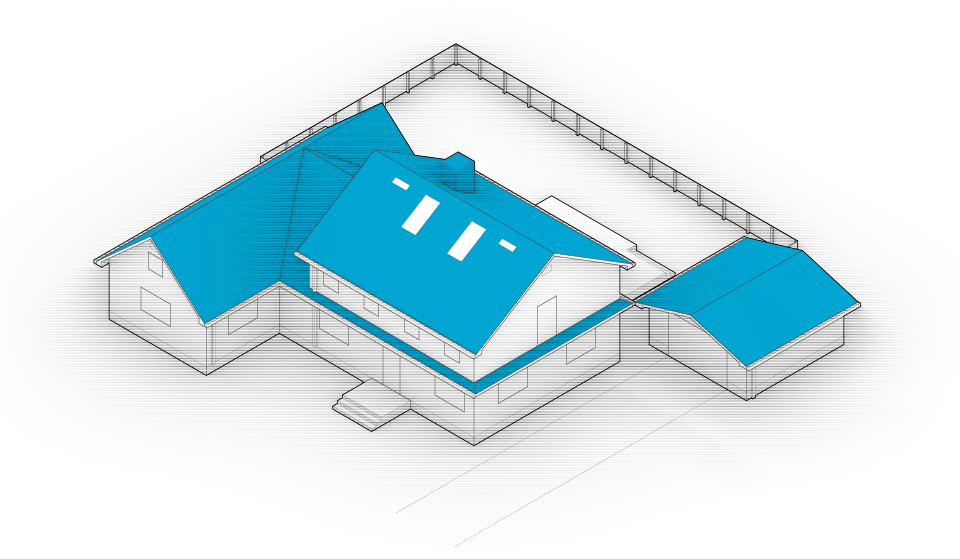
HOUSE
A resilient landscape is fire-wise, water wise and promotes biodiversity by using California native plants. These gardens use sustainable practices, plant selection, and maintenance to reduce the risk of fire in the defensible space zone. Resilient gardens save water, protect us from fire and promote biodiversity.
UPGRADE
Roof
The roof is the most vulnerable component of your home! During a wildfire it must be able to resist wind-blown embers and other wildfire exposures. Complex roofs, where the roof meets vertical walls and/or includes dormers, present additional vulnerabilities. Replacing a roof is a major project, but it can yield major benefits. Evaluating the vulnerability of the roof should be a top priority when considering a new home or remodeling an existing property. Proper roof maintenance is critical to reduce the ignition risk of your home!
Replacing a roof is a major project, but it can yield major benefits. Evaluating the vulnerability of the roof should be a top priority when considering a new home or remodeling an existing property.
RELATIVE COST AND PRIORITY LEVEL OF HOME HARDENING FEATURES FOR FIRE-RESISTANCE
 |
 |
 |
 |
 |
 |
|
 |
||||||
 |
 |
 |
 |
|||
 |
||||||
Relative cost: Indicates the relative cost of upgrading the listed features to ember-resistant materials and design.
Priority level: Indicated the features most vulnerable to wildfires and embers. Keep in mind each situation is unique and may change your priority level.
 Replace with Class A Roof
Replace with Class A Roof
Re-roof with materials such as composition, metal or tile (see Class A materials in recommendations for new constructions). An untreated wood shake or shingle roof covering is arguably the greatest threat to a building.
 Block Spaces Between Roof Decking and Covering
Block Spaces Between Roof Decking and Covering
Block any spaces between roof decking and covering to prevent ember intrusion (also known as “bird-stopping”).
Regular Inspections
Regularly inspect and maintain vulnerable areas on your roof including valley, dormers, gutters, skylights.
 Ask a Professional
Ask a Professional
It can be difficult to tell whether you have a Class A fire-rated roof. If you are not sure about the fire rating of your roof covering, schedule an inspection by a professional roofer to find out. If you replace your roof, choose one that has a Class A fire rating.
 Cover Chimney with Screen
Cover Chimney with Screen
Windborne embers and firebrands can enter your home through your chimney or stovepipe outlet if it is not protected and maintained correctly. Vegetation debris can also accumulate on the roof adjacent to the chimney chase. This is another roof-to-wall connection that can be vulnerable to ignition by embers.
- Cover your chimney and stovepipe outlets with noncombustible corrosion corrosion-resistant metal mesh screen (spark arrestor), with 3/8-inch to 1/2-inch openings. Do not use fiberglass or plastic mesh as they can melt or burn.
- Remove tree branches within 10 feet of any chimney outlet.
- Install metal-flashing at roof-to-siding intersection to reduce the vulnerability of the chimney chase.
CALFIRE provides a list of Wildland Urban Interface (WUI) Approved Products.
Visit their website and search for “8180 – Non-Wood Roof Covering / Assemblies for Wildland Urban Interface (WUI)”
Resources:
Wildfire Research Fact Sheet – Roofing materials (NFPA, 2017)
P-737 Home Builder’s Guide to Construction in Wildfire Zones (FEMA, 2008)
Ready, Set, Go! Your Personal Wildland Fire Action Guide (FireSafe Sonoma, 2019)
Su Guía de Acción en Caso de Incendio Forestal (FireSafe Sonoma, 2019)
Home Survival in Wildfire-Prone Areas: Building Materials and Design Considerations (UCANR, 2010)
Homeowner’s Wildfire Mitigation Guide – Roof Covering (UCANR, 2019)
Wildfire Home Retrofit Guide (University of Nevada, Reno Extension, 2020)
Preparing Your Home (University of California Cooperative Extension, 2022)
State Fire Marshal Listed Wildland Urban Interface (WUI) Products Handbook (Cal Fire, 2021)
Gutters
Wind-blown debris (including leaves and pine needles from nearby and overhanging trees) will accumulate on roofs and in gutters. Dry debris can be ignited by wind-blown embers. These flames can extend to the edge of the roof and adjacent siding. Even with Class A fire-rated roof coverings, vertical surfaces next to the roof edge will be exposed to flames from the ignited debris. Upgrade your gutters to prevent wind-blown debris from accumulating on your roof and in your gutters.
RELATIVE COST AND PRIORITY LEVEL OF HOME HARDENING FEATURES FOR FIRE-RESISTANCE
 |
 |
 |
 |
 |
 |
|
 |
||||||
 |
 |
 |
 |
|||
 |
||||||
Relative cost: Indicates the relative cost of upgrading the listed features to ember-resistant materials and design.
Priority level: Indicated the features most vulnerable to wildfires and embers. Keep in mind each situation is unique and may change your priority level.
 Install Leaf Guard
Install Leaf Guard
Install noncombustible leaf guards over gutters to prevent the accumulation of combustible debris. Types of leaf guards include metal-mesh screens and metal hoods that fit into the gutter.
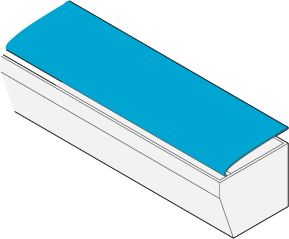 Use Noncombustible Materials
Use Noncombustible Materials
Use gutters and downspouts constructed of noncombustible materials such as galvanized steel, copper, and aluminum. Metal hood leaf guards are recommended because they do not melt and are relatively effective in keeping debris out of gutters.
 Install Drip Edge
Install Drip Edge
Some metal gutters have an integral flashing piece that serves the function of a stand-alone drip edge. If a drip edge is not present, install one.
The drip edge will serve two purposes:
- it will help protect the roof edge (sheathing and fascia) from a flaming exposure that could occur if debris is ignited by wind-blown embers, and
- it will minimize the entry of embers into a soffited-eave construction by blocking the small gap that can exist between the edge of the roof sheathing and the top of the fascia.
Sources:
Wildfire Research Fact Sheet – Roofing Materials (NFPA, 2017)
Fact Sheet No. 9 – Gutters and Downspouts (FEMA, 2008)
P-737 Home Builder’s Guide to Construction in Wildfire Zones (FEMA, 2008)
Building and Living in the WUI (VCoFD, 2019)
Home Survival in Wildfire-Prone Areas: Building Materials and Design Considerations (UCANR, 2010)
Eaves, Overhangs, Sofits
Eaves are located at the down-slope edge of a sloped roof and serve as the transition between the roof and fascia/wall. An eave typically has a metal edge flashing and gutter that are attached to a wood fascia trim board. Renovating or upgrading under-eaves can help protect against windborne embers, convective heat, and radiant heat that can be trapped under overhangs and in the upper portion of exterior walls. Overhangs and walls can ignite if not constructed of noncombustible or fire-resistant materials.
RELATIVE COST AND PRIORITY LEVEL OF HOME HARDENING FEATURES FOR FIRE-RESISTANCE
 |
 |
 |
 |
 |
 |
|
 |
||||||
 |
 |
 |
 |
|||
 |
||||||
Relative cost: Indicates the relative cost of upgrading the listed features to ember-resistant materials and design.
Priority level: Indicated the features most vulnerable to wildfires and embers. Keep in mind each situation is unique and may change your priority level.
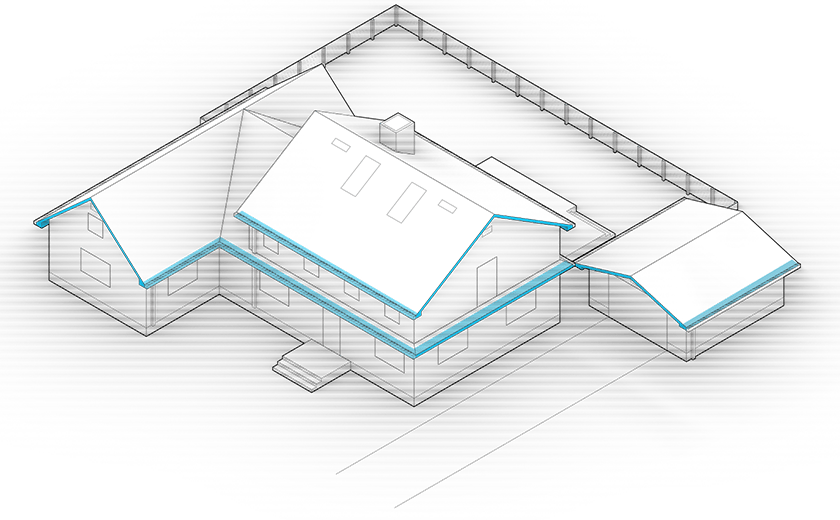
Retrofit recommendations

- Evaluate the fire-resistance of existing soffits and replace soffits that are not fire-resistant. Existing soffits (such as those constructed of plywood) can be covered with a noncombustible or fire-resistant material such as fiber-cement board or stucco.
- If the fascia is combustible, cover the fascia board with a noncombustible or fire-resistant material (e.g., fire-retardant-treated lumber, fiber-cement board).
- If you have open overhangs, install a soffit with a minimum 1-hour fire-resistance rating
- Install exterior 5/8-inch fire-resistant gypsum board between the existing and new soffit materials for enhanced fire resistance.
CALFIRE provides a list of Wildland Urban Interface (WUI) Approved Products. Visit their website and search for “8180 – Non-Wood Roof Covering / Assemblies for Wildland Urban Interface (WUI)”
Sources:
How To Prepare Your Home for Wildfire (NFPA)
Wildfire Research Fact Sheet – Under-eave construction (NFPA, 2017)
Fact Sheet No. 6 – Eaves, Overhangs, and Soffits (FEMA, 2008)
P-737 Home Builder’s Guide to Construction in Wildfire Zones (FEMA, 2008)
Building and Living in the WUI (VCoFD, 2019)
Home Survival in Wildfire-Prone Areas: Building Materials and Design Considerations (UCANR, 2010)
Vents
Roof vents are important features for air circulation and removing excess moisture in the attic. However, they are highly vulnerable to flame entry and ember attacks. Installing shutters, louver blades and metal screens can help preventing embers from getting inside the building, but they do not prevent the entry of hot gases generated by wildfire and nearby vegetation. As an additional protection measure, consider installing fire dampers within the ducts of your HVAC system. If sufficiently high heat penetrates, the fire damper will automatically close and prevent high heat from penetrating farther into the structure.
RELATIVE COST AND PRIORITY LEVEL OF HOME HARDENING FEATURES FOR FIRE-RESISTANCE
 |
 |
 |
 |
 |
 |
|
 |
||||||
 |
 |
 |
 |
|||
 |
||||||
Relative cost: Indicates the relative cost of upgrading the listed features to ember-resistant materials and design.
Priority level: Indicated the features most vulnerable to wildfires and embers. Keep in mind each situation is unique and may change your priority level.

 Replace with Metal Vents
Replace with Metal Vents
If the home has ridge vents or wall louvers and they are not metal, replace them with metal vents according to the guidance provided above.
 Install Screens
Install Screens
If existing vent openings do not have screens or if the screen openings are larger than 1/4‑inch, install corrosive-resistant, metal mesh screens with a maximum opening of 1/8 inch (3.2 mm).
 Install Shutters
Install Shutters
Install shutters over gable-end vents, soffit vents, crawlspace vents, and wall louvers.
If the existing wall or soffit is combustible, shutters may not be effective. In this case, installing shutters is probably cost-effective only if done in conjunction with upgrades to the wall or soffit.
CAL FIRE provides a list of Wildland Urban Interface (WUI) Approved Products including roofing material and vents. Visit their website and search for “8165 – Vents for Wildland Urban Interface (WUI)”
Sources:
Wildfire Research Fact Sheet – Roofing Materials (NFPA, 2017)
Fact Sheet No. 8 – Vents (FEMA, 2008)
P-737 Home Builder’s Guide to Construction in Wildfire Zones (FEMA, 2008)
Building and Living in the WUI (VCoFD, 2019)
Home Survival in Wildfire-Prone Areas: Building Materials and Design Considerations (UCANR, 2010)
Windows, Sliding Glass Doors, Skylights
Windows, sliding glass doors, and skylights are key structure components to prevent ignition of the interior of your home because of intrusion of windborne embers, hot gases and radiant heat. You can reduce your ignition risk by following these recommendations for upgrading:
RELATIVE COST AND PRIORITY LEVEL OF HOME HARDENING FEATURES FOR FIRE-RESISTANCE
 |
 |
 |
 |
 |
 |
|
 |
||||||
 |
 |
 |
 |
|||
 |
||||||
Relative cost: Indicates the relative cost of upgrading the listed features to ember-resistant materials and design.
Priority level: Indicated the features most vulnerable to wildfires and embers. Keep in mind each situation is unique and may change your priority level.

 Replace with Fire-resistant Materials / Glazing
Replace with Fire-resistant Materials / Glazing
Windows and sliding glass doors, including frames, that are susceptible to damage from a wildfire should be replaced with the components listed for new construction and/or protected by shutters.
 Beware of Door Vision Panels
Beware of Door Vision Panels
Door vision panels that are susceptible to damage from a wildfire should be replaced with tempered glass with a low-e reflective coating.
 Use Fire-resistant Glazing for Skylights
Use Fire-resistant Glazing for Skylights
Skylights with plastic glazing should be replaced with a more resistant glazing to avoid melting under radiant heat during a wildfire
CAL FIRE provides a list of Wildland Urban Interface (WUI) Approved Products. Visit their website and search for “8120 – Exterior Windows for Wildland Urban Interface (WUI)”
Sources:
How To Prepare Your Home for Wildfire (NFPA)
Wildfire Research Fact Sheet – Skylights (NFPA, 2017)
Fact Sheet No. 10 – Windows and Skylights (FEMA, 2008)
P-737 Home Builder’s Guide to Construction in Wildfire Zones (FEMA, 2008)
Building and Living in the WUI (VCoFD, 2019)
Home Survival in Wildfire-Prone Areas: Building Materials and Design Considerations (UCANR, 2010)
Doors
Exterior doors are subject to the same types of exposure as exterior walls but are usually much thinner and less resistant, making them an important component in your home hardening plan. To protect your home and reinforce your existing doors against flames, hot gases, flying embers and firebrands, follow the upgrade recommendations below to increase fire resistance of your opening and decrease heat transmission.
RELATIVE COST AND PRIORITY LEVEL OF HOME HARDENING FEATURES FOR FIRE-RESISTANCE
 |
 |
 |
 |
 |
 |
|
 |
||||||
 |
 |
 |
 |
|||
 |
||||||
Relative cost: Indicates the relative cost of upgrading the listed features to ember-resistant materials and design.
Priority level: Indicated the features most vulnerable to wildfires and embers. Keep in mind each situation is unique and may change your priority level.

 Exterior Doors
Exterior Doors
- Add weatherstripping to doors.
- Replace vision panels in doors (check our Windows & Skylights section).
 Sliding Doors
Sliding Doors
Replace sliding glass doors and/or protect with shutters (check our Windows & Skylights section).
 Garage Doors
Garage Doors
Replace wooden garage doors, particularly if they do not have a solid core.
CAL FIRE provides a list of Wildland Urban Interface (WUI) Approved Products. Visit their website and search for “”8150 – Exterior Door for Wildland Urban Interface (WUI)””
Sources:
How To Prepare Your Home for Wildfire (NFPA)
Fact Sheet No. 11: Exterior Doors (FEMA, 2008)
P-737 Home Builder’s Guide to Construction in Wildfire Zones (FEMA, 2008)
Building and Living in the WUI (VCoFD, 2019)
Home Survival in Wildfire-Prone Areas: Building Materials and Design Considerations (UCANR, 2010)
Walls, Sidings, Coatings
Exterior walls are susceptible to wildfire flames, conductive heat, and radiant heat. Flames and heat can ignite combustible wall coverings. When exterior walls ignite, the fire can spread to other components of the building such as the roof, soffit, windows, and doors, resulting in substantial damage to or total loss of the building. Windborne embers and firebrands are also sources of ignition. Embers can become trapped in cracks in walls, window openings, and door trim boards.
RELATIVE COST AND PRIORITY LEVEL OF HOME HARDENING FEATURES FOR FIRE-RESISTANCE
 |
 |
 |
 |
 |
 |
|
 |
||||||
 |
 |
 |
 |
|||
 |
||||||
Relative cost: Indicates the relative cost of upgrading the listed features to ember-resistant materials and design.
Priority level: Indicated the features most vulnerable to wildfires and embers. Keep in mind each situation is unique and may change your priority level.

Replace with Recommended Materials

Replace exterior wall coverings with recommended materials for new construction if your current coverings are:
- combustible
- susceptible to melting
- can readily transmit heat
Examples of the types of coverings that need to be replaced are wood siding that is not fire-retardant-treated, vinyl siding, metal siding susceptible of warping, and an exterior insulation finish system.
Before replacing vinyl or metal siding, check whether there is an underlying gypsum board substrate. If so, remedial work may not be needed.
Determine whether keeping the existing covering and covering it with 5/8-inch type X gypsum board and a new covering is a viable option.
 Remove Debris
Remove Debris
Remember to clean and remove combustible debris (e.g. vegetation and leaves, firewood…) near the exterior walls regularly to reduce your vulnerability to ignition during a wildfire.
CAL FIRE provides a list of Wildland Urban Interface (WUI) Approved Products. Visit their website and search for “8140 – Exterior Wall Siding and Sheathing for Wildland Urban Interface (WUI)”
Sources:
How To Prepare Your Home for Wildfire (NFPA)
Wildfire Research Fact Sheet – Coatings (NFPA, 2017)
Fact Sheet No. 7: Exterior Walls (FEMA, 2008)
P-737 Home Builder’s Guide to Construction in Wildfire Zones (FEMA, 2008)
Building and Living in the WUI (VCoFD, 2019)
Home Survival in Wildfire-Prone Areas: Building Materials and Design Considerations (UCANR, 2010)
Fences
Landscape fencing and walls that are attached to or near buildings in wildfire zones can represent a high ignition risk by spreading flames or radiant heat from one building to another. The common wooden post-and-board fence can become fuel for a wildfire, especially when the fence is old and weather-beaten. It can also collect embers and firebrands in a wildfire and act as a horizontal ladder fuel by allowing the fire to travel along the fence. Existing wood fences that are attached to the home should be modified so that the fence ends with a noncombustible component, such as masonry or metal, to minimize the chance of fire spreading to the home or business.
RELATIVE COST AND PRIORITY LEVEL OF HOME HARDENING FEATURES FOR FIRE-RESISTANCE
 |
 |
 |
 |
 |
 |
|
 |
||||||
 |
 |
 |
 |
|||
 |
||||||
Relative cost: Indicates the relative cost of upgrading the listed features to ember-resistant materials and design.
Priority level: Indicated the features most vulnerable to wildfires and embers. Keep in mind each situation is unique and may change your priority level.

Use of Metal Plate
A common technique is to use a metal gate with one side attached to the combustible fence and the other to the exterior siding. Some checklists recommend inserting a metal plate where the fence connects to the exterior wall of a building, particularly when combustible siding is used.
How effective the flashing will be will depend on the size of the metal strip. Depending on how it is attached to the exterior wall, over time it could result in other moisture-related degradation problems with the siding.
 Key considerations for increased fire safety:
Key considerations for increased fire safety:
- Avoid attaching fences and walls constructed of combustible materials to a building.
- For fences and walls that are attached to a building, ensure that all combustible components are at least 10 feet from the building to prevent heat and flames from igniting the building.
- Avoid fences that have gaps, such as wooden slat fences, because airborne firebrands can become trapped in the gaps and ignite the fence
- Avoid combustible mulch and vegetation within at least 2’ of combustible fencing.
Sources:
How To Prepare Your Home for Wildfire (NFPA)
Wildfire Research Fact Sheet – Fencing (NFPA, 2017)
Fact Sheet No. 14 – Landscape Fences and Walls (FEMA, 2008)
P-737 Home Builder’s Guide to Construction in Wildfire Zones (FEMA, 2008)
Building and Living in the WUI (VCoFD, 2019)
Home Survival in Wildfire-Prone Areas: Building Materials and Design Considerations (UCANR, 2010)
Decks
Decks are important features because they are usually attached to a home and are next to a window or sliding glass access door. To minimize the possibility of deck ignitions, reduce fuels in the home ignition zones by carefully selecting and positioning vegetation and implementing regular maintenance.
RELATIVE COST AND PRIORITY LEVEL OF HOME HARDENING FEATURES FOR FIRE-RESISTANCE
 |
 |
 |
 |
 |
 |
|
 |
||||||
 |
 |
 |
 |
|||
 |
||||||
Relative cost: Indicates the relative cost of upgrading the listed features to ember-resistant materials and design.
Priority level: Indicated the features most vulnerable to wildfires and embers. Keep in mind each situation is unique and may change your priority level.

 Plastic and Wood-plastic are also Combustible
Plastic and Wood-plastic are also Combustible
It is common knowledge that wood deck boards are combustible. There is sometimes a misunderstanding regarding the combustibility of plastic and wood-plastic composite decking products—these decking products are also combustible.
Beware Fuel Near Decks
Do not store combustible material beneath the deck.
 Replace with Fire-retardant Materials
Replace with Fire-retardant Materials
If the deck is a non-fire retardant treated softwood deck, consider removing and replacing deck boards within a few feet of the house. Be careful to match the deck board thickness select deck boards that comply with the California Building Code requirements.
CAL FIRE provides a list of Wildland Urban Interface (WUI) Approved Products. Visit their website and search for “8110 – Decking for Wildland Urban Interface (WUI)”
Sources:
How To Prepare Your Home for Wildfire (NFPA)
Wildfire Research Fact Sheet – Decks (NFPA, 2017)
Wildfire Research Fact Sheet – Fire spread on ember-ignited decks (NFPA, 2017)
Fact Sheet No. 13 – Decks and Other Attached Structures (FEMA, 2008)
P-737 Home Builder’s Guide to Construction in Wildfire Zones (FEMA, 2008)
Building and Living in the WUI (VCoFD, 2019)
Home Survival in Wildfire-Prone Areas: Building Materials and Design Considerations (UCANR, 2010)
Defensive Systems
Defensive actions can potentially help your home survive a wildfire. These actions are in addition to creating and maintaining defensible space on your property and selection of appropriate building materials listed on this website.
RELATIVE COST AND PRIORITY LEVEL OF HOME HARDENING FEATURES FOR FIRE-RESISTANCE
 |
 |
 |
 |
 |
 |
|
 |
||||||
 |
 |
 |
 |
|||
 |
||||||
Relative cost: Indicates the relative cost of upgrading the listed features to ember-resistant materials and design.
Priority level: Indicated the features most vulnerable to wildfires and embers. Keep in mind each situation is unique and may change your priority level.
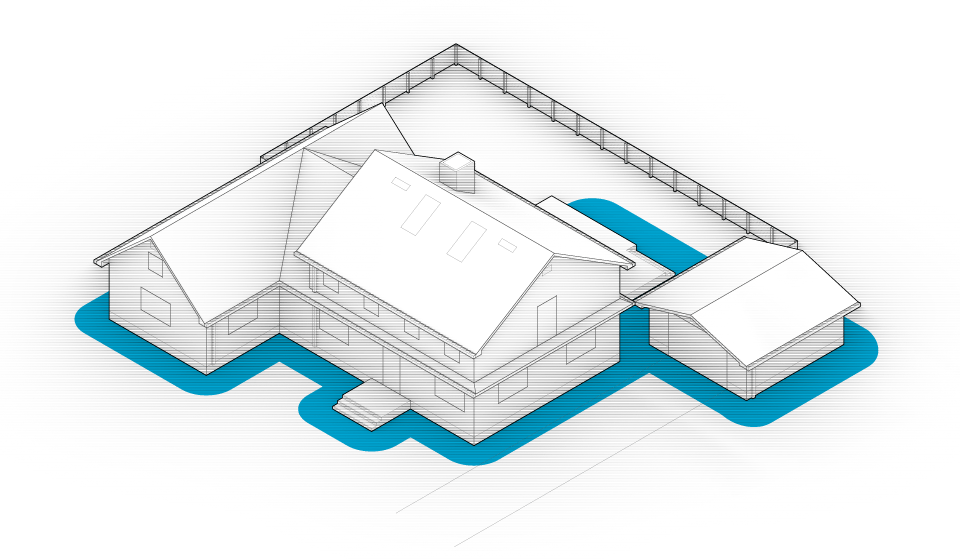
 Exterior Water Spray Systems
Exterior Water Spray Systems
An exterior water spray system can be roof- or ground-mounted. The objective of the sprinklers is to limit the spread of the fire to the home and/or extinguish wind-blown embers before they reach the building being protected. It is important to understand that the effectiveness of an external sprinkler system has not been completely evaluated.
If you are considering an external sprinkler system, check with your local fire department. They may have plans, and other suggestions. In order to maximize the effectiveness of exterior sprinklers, they should be on a stand-alone, independent water system (i.e., tank, pool or lake) and should be attached to a pressurized delivery system or use a generator for needed pumps.
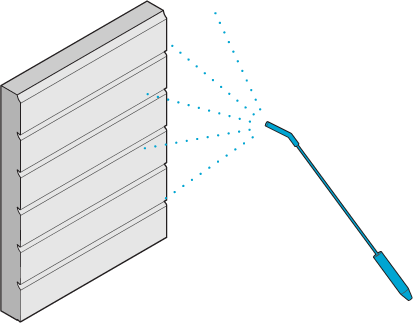 Gel Coating
Gel Coating
Gels are water absorbent polymers that can be applied to a building component to provide temporary protection from radiant heat or flames. You may have heard of these products being applied to homes when a wildfire is threatening. Once applied, the absorbed water starts to evaporate, whether or not the wildfire actually arrives, and therefore the time that a gel coating is effective is limited. The effective time is on the order of hours. It is not warranted to rely on a coating in lieu of managing vegetation or improving building materials and design.
Given the potential issues regarding performance, it is recommended that the use of defensive actions be a supplement to, and not a replacement for, already proven mitigation strategies, such as the reduction of potential fuels throughout the home ignition zones, along with removal of roof and gutter debris, and use of noncombustible and fire/ember-ignition resistant building materials and installation design details.
Sources:
How To Prepare Your Home for Wildfire (NFPA)
Wildfire Research Fact Sheet – Exterior Sprinklers Systems (NFPA, 2017)
Wildfire Research Fact Sheet – Fire spread on ember-ignited decks (NFPA, 2017)
Fact Sheet No. 15 – Fire Sprinklers (FEMA, 2008)
Fact Sheet No. 16 – Utilities and Exterior Equipment (FEMA, 2008)
P-737 Home Builder’s Guide to Construction in Wildfire Zones (FEMA, 2008)
Building and Living in the WUI (VCoFD, 2019)
Home Survival in Wildfire-Prone Areas: Building Materials and Design Considerations (UCANR, 2010)
